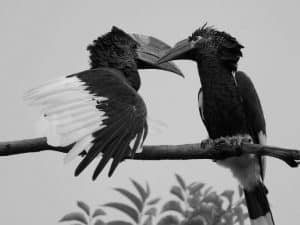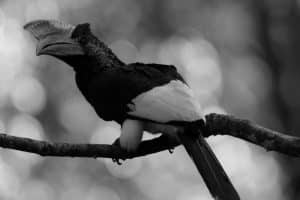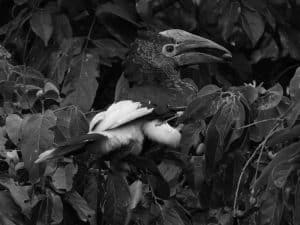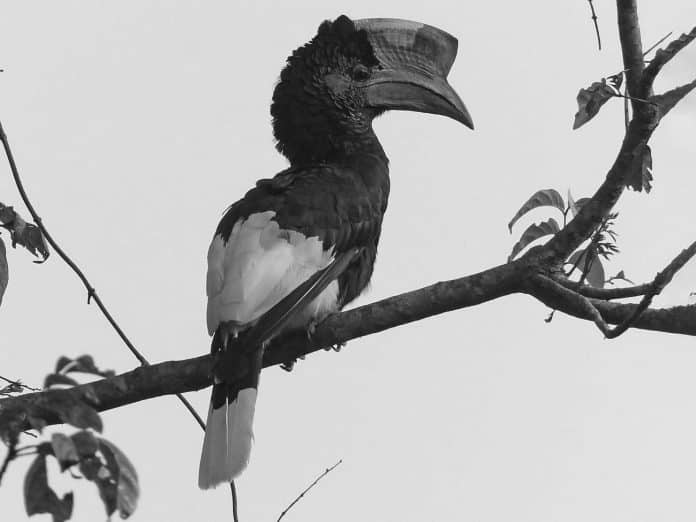Introduction to the Black-and-White-Casqued Hornbill
The Black-and-White-Casqued Hornbill, scientifically known as Bycanistes subcylindricus, is a majestic bird species found in the lush jungles of Tanzania. This beautiful hornbill is known for its striking black and white plumage, with a prominent casque adorning its bill, making it a captivating sight in its natural habitat. The Black-and-White-Casqued Hornbill in Tanzania belongs to the Bucerotidae family and is a significant part of Tanzania’s rich biodiversity. As you delve into the realm of this remarkable avian species, you will discover its habitat, unique characteristics, behaviors, and the crucial role it plays in the Tanzanian ecosystems.
Habitat and Distribution of the Black-and-White-Casqued Hornbill in Tanzania

The Black-and-White-Casqued Hornbill primarily inhabits the dense and verdant forests of Tanzania, including the lowland and submontane rainforests. These forests provide the hornbills with ample food sources, nesting sites, and protection, allowing them to thrive in these vibrant ecosystems. You can often spot these magnificent birds perched on tree branches, foraging for fruits, small vertebrates, and insects. The distribution of the Black-and-White-Casqued Hornbill spans across various regions of Tanzania, including the Udzungwa Mountains, the Eastern Arc Mountains, and the coastal forests of eastern Tanzania. Its presence in these diverse habitats highlights the adaptability of this species to different environmental conditions, making it an integral part of Tanzania’s natural heritage.
The conservation of the Black-and-White-Casqued Hornbill’s habitat is crucial to ensure the continued existence of this species in Tanzania. Deforestation, habitat fragmentation, and human encroachment pose significant threats to the hornbill’s natural environment. Conservation efforts focused on preserving and restoring the forests of Tanzania are essential in safeguarding the Black-and-White-Casqued Hornbill’s habitat and ensuring a sustainable future for this iconic bird.
Unique Characteristics and Behaviors of the Black-and-White-Casqued Hornbill
The Black-and-White-Casqued Hornbill possesses several striking features that set it apart in the avian world. One of its most distinctive attributes is the casque, a hollow structure located on top of its bill. The casque serves both ornamental and practical purposes, playing a role in acoustic communication and providing protection during territorial disputes. Additionally, the black and white plumage of the hornbill creates a visually stunning contrast, making it a captivating sight amidst the green canopy of the Tanzanian forests.
In terms of behavior, the Black-and-White-Casqued Hornbill exhibits fascinating social dynamics and breeding rituals. These birds are known for their monogamous mating system, where pairs engage in elaborate courtship displays and maintain strong bonds throughout the breeding season. The female hornbill seals herself inside a tree cavity during the nesting period, relying on the male to provide her with food through a narrow opening. This unique nesting behavior showcases the remarkable adaptation and cooperation displayed by the Black-and-White-Casqued Hornbill in ensuring the survival of its offspring.
Conservation Efforts for the Black-and-White-Casqued Hornbill in Tanzania
Conservation initiatives focused on protecting the Black-and-White-Casqued Hornbill are pivotal in safeguarding the future of this species in Tanzania. The establishment of protected areas and national parks, such as the Udzungwa Mountains National Park and the Kilombero Nature Reserve, plays a significant role in preserving the hornbill’s habitat and fostering biodiversity conservation. These protected areas provide vital sanctuaries for the Black-and-White-Casqued Hornbill, offering a safe haven for nesting, foraging, and maintaining their population levels.
Furthermore, community-based conservation programs that involve local communities in forest management and sustainable resource utilization contribute to the long-term protection of the hornbill’s habitat. By engaging with indigenous communities and promoting eco-friendly practices, conservationists work towards creating harmonious coexistence between human activities and the conservation of the Black-and-White-Casqued Hornbill and its habitat.
The Role of the Black-and-White-Casqued Hornbill in Tanzanian Ecosystems
The Black-and-White-Casqued Hornbill plays a vital role in the intricate web of Tanzanian ecosystems, contributing to seed dispersal, insect control, and forest regeneration. As frugivorous birds, they consume a variety of fruits and play a crucial role in dispersing seeds across the forest landscape. By ingesting fruits and excreting the seeds in different locations, the hornbills facilitate the regeneration of plant species and contribute to the overall biodiversity of the forests. Additionally, their foraging behavior helps in controlling insect populations, maintaining the ecological balance within their habitat.
The presence of the Black-and-White-Casqued Hornbill serves as an indicator of the overall health and biodiversity of the Tanzanian jungles. By monitoring the population dynamics and distribution of these hornbills, conservationists gain valuable insights into the state of the ecosystems and the impact of human activities on the natural environment. Protecting the habitat and well-being of the Black-and-White-Casqued Hornbill is not only essential for the survival of this species but also for the preservation of the entire ecological network it is a part of.
Cultural Significance of the Black-and-White-Casqued Hornbill in Tanzania

In Tanzanian culture, the Black-and-White-Casqued Hornbill holds a special place, often symbolizing wisdom, power, and spiritual significance. The striking appearance and distinctive behaviors of the hornbill have inspired folklore, traditional rituals, and artistic expressions within local communities. The hornbill’s image is sometimes incorporated into traditional crafts, dances, and ceremonial attire, reflecting the reverence and admiration for this iconic bird.
Moreover, the conservation of the Black-and-White-Casqued Hornbill is intertwined with the preservation of cultural heritage and indigenous knowledge. Efforts to protect the hornbill’s habitat and promote sustainable practices align with the cultural values and traditions of the communities living in proximity to the bird’s natural environment. By recognizing the cultural significance of the Black-and-White-Casqued Hornbill, conservation initiatives can foster greater cooperation and collaboration with local populations, leading to more effective conservation outcomes.
Challenges Facing the Black-and-White-Casqued Hornbill Population in Tanzania
Despite its cultural and ecological significance, the Black-and-White-Casqued Hornbill faces various challenges that threaten its population in Tanzania. Habitat loss due to deforestation, logging, and agricultural expansion poses a significant threat to the hornbill’s natural habitat. Fragmentation of forests further exacerbates the isolation of hornbill populations, impacting their breeding success and genetic diversity. Additionally, illegal wildlife trade and hunting activities contribute to the decline of the hornbill population, as their casques and feathers are sometimes sought after for traditional and commercial purposes.
Climate change also presents a growing concern, affecting the availability of food sources and altering the environmental conditions that the Black-and-White-Casqued Hornbill relies on for survival. The changing climate patterns and extreme weather events can disrupt breeding cycles, impact food availability, and create additional stressors for the hornbill population. Addressing these multifaceted challenges requires comprehensive strategies that integrate conservation, community engagement, and sustainable development practices.
Initiatives for Sustainable Tourism and Wildlife Viewing of the Black-and-White-Casqued Hornbill

Sustainable tourism and responsible wildlife viewing offer opportunities to appreciate the beauty of the Black-and-White-Casqued Hornbill while supporting its conservation in Tanzania. Ecotourism initiatives that promote ethical and low-impact travel experiences enable visitors to observe these magnificent birds in their natural habitat, fostering a deeper understanding of the importance of preserving the hornbill’s environment. By engaging with local guides and conservation experts, tourists can gain insights into the ecological significance of the hornbill and the efforts undertaken to protect its existence.
Furthermore, the development of birdwatching and nature-based tourism programs creates economic incentives for local communities to actively participate in conservation efforts. Revenue generated from sustainable tourism can be reinvested into habitat restoration, community development projects, and educational programs focused on raising awareness about the Black-and-White-Casqued Hornbill and its conservation needs. Through responsible tourism practices, visitors can contribute to the long-term sustainability of the hornbill’s habitat and support the conservation initiatives aimed at preserving Tanzania’s natural heritage.
Conclusion: Celebrating the Monochrome Majesty of the Black-and-White-Casqued Hornbill
In conclusion, the Black-and-White-Casqued Hornbill’s presence in the jungles of Tanzania is a testament to the country’s rich biodiversity and cultural heritage. By understanding the habitat, unique characteristics, behaviors, and the challenges faced by this iconic bird, we gain a profound appreciation for its significance in Tanzanian ecosystems. Conservation efforts focused on protecting the hornbill’s habitat, engaging with local communities, and promoting sustainable tourism are essential in ensuring the continued existence of the Black-and-White-Casqued Hornbill for future generations to marvel at.
As we celebrate the monochrome majesty of the Black-and-White-Casqued Hornbill, let us recognize the interconnectedness of all living beings and the importance of preserving the natural world. Whether through conservation initiatives, cultural appreciation, or responsible tourism practices, each of us can contribute to the safeguarding of this magnificent bird and the diverse ecosystems it inhabits. Together, we can uphold the legacy of the Black-and-White-Casqued Hornbill in Tanzania, ensuring that it continues to grace the jungles with its timeless presence.


































